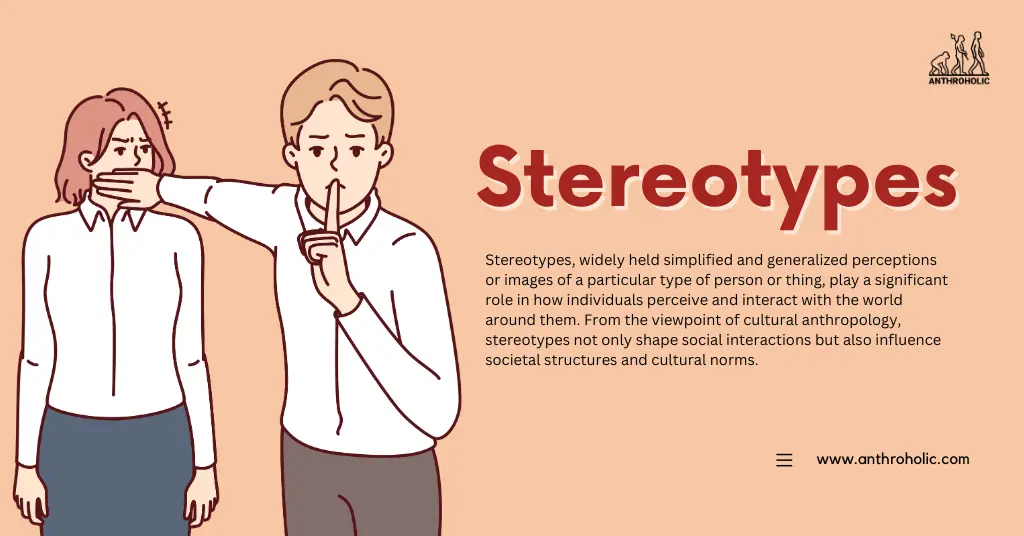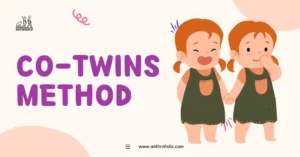AI Answer Evaluation Platform Live Now. Try Free Answer Evaluation Now
Stereotypes
Stereotypes, widely held simplified and generalized perceptions or images of a particular type of person or thing, play a significant role in how individuals perceive and interact with the world around them [1]. From the viewpoint of cultural anthropology, stereotypes not only shape social interactions but also influence societal structures and cultural norms.

Understanding Stereotypes
Definition and Types
Stereotypes are often classified into three categories:
- Personal stereotypes: These are the assumptions that an individual makes about a group based on their personal experiences or information.
- Group stereotypes: These are the shared beliefs about a group that are prevalent within a social community.
- Cultural stereotypes: These are the shared assumptions about a group that are integrated into the culture, customs, and institutions of a society.
Table 1: Categories of Stereotypes
| Category | Description |
|---|---|
| Personal Stereotypes | Derived from personal experiences or information |
| Group Stereotypes | Common beliefs shared within a social community |
| Cultural Stereotypes | Assumptions integrated into the culture and institutions of a society |
Stereotypes and Cultural Anthropology
Cultural anthropology, a branch of anthropology that studies cultural variation among humans, can provide a unique perspective on stereotypes. It helps us understand the origins, development, and effects of stereotypes within a particular culture or society [2].
The Role and Impact of Stereotypes
Stereotypes as Cultural Products
Stereotypes are cultural products shaped by the collective beliefs, attitudes, and experiences of a group of people. They are a means of simplifying complex social realities, acting as shorthand for the human cognitive process when dealing with large amounts of social information [3].
The Impact of Stereotypes on Perception and Behavior
Stereotypes have profound impacts on our perceptions, attitudes, and behaviors. They can perpetuate social inequalities and maintain power dynamics by devaluing marginalized groups while reaffirming the status quo for more privileged groups. Moreover, stereotypes can lead to prejudice and discrimination, creating barriers to social integration and cohesion [4].
The Dangers of Stereotyping
The danger lies not in the existence of stereotypes, but in the unquestioned acceptance of them as truth. Stereotypes can become self-fulfilling prophecies, shaping behaviors and experiences in ways that confirm these preconceived notions [5].
Deconstructing Stereotypes: An Anthropological Approach
Analyzing Stereotypes
Cultural anthropologists study stereotypes to uncover the underlying cultural structures and societal attitudes that they reflect. By using ethnography and comparative analysis, they can scrutinize how stereotypes are created, perpetuated, and challenged within a culture.
Challenging Stereotypes
Anthropologists can play a vital role in challenging stereotypes by:
- Educating individuals about the social construction of stereotypes
- Promoting cultural understanding and respect for diversity
- Advocating for societal changes that challenge stereotypical thinking
Table 2: Role of Anthropologists in Challenging Stereotypes
| Role | Description |
|---|---|
| Education | Increasing awareness about the social construction of stereotypes |
| Promotion of Diversity | Promoting understanding and respect for cultural diversity |
| Advocacy | Advocating for societal changes to challenge stereotypical thinking |
Stereotypes and Cultural Transmission
The Social Learning Theory
Stereotypes are passed down from one generation to another through a process of cultural transmission. The social learning theory posits that people learn from one another, via observation, imitation, and modeling. This theory, presented by Albert Bandura, asserts that individuals, especially children, learn many social behaviors and attitudes, including stereotypes, from observing those around them [6].
The Role of Media and Education
Media and education play significant roles in the propagation of stereotypes. Media outlets often depict stereotypical images and narratives that reinforce existing societal stereotypes. Similarly, educational institutions can inadvertently propagate stereotypes through biased curricular content [7].
Table 3: Propagators of Stereotypes
| Propagators | Role in Stereotype Propagation |
|---|---|
| Media | Depicting stereotypical images and narratives |
| Education | Inadvertently propagating stereotypes through biased curricular content |
Stereotypes and Identity Formation
The Social Identity Theory
The social identity theory postulates that stereotypes contribute significantly to the formation of social identity. This theory, proposed by Henri Tajfel and John Turner, suggests that individuals categorize themselves and others into in-groups and out-groups, leading to biases in favor of the in-group [8].
Stereotypes and Self-Concept
Repeated exposure to stereotypes can impact how individuals perceive themselves, often leading to the internalization of these stereotypes. This internalization can then influence their behavior, perpetuating the stereotype further [9].
Counteracting Stereotypes
Encouraging Critical Thinking
Promoting critical thinking can help individuals recognize the biases inherent in stereotypical thinking. It encourages them to question the validity of these stereotypes and helps them understand the nuanced complexity of social realities [10].
Promoting Intercultural Dialogue
Encouraging intercultural dialogue can help break down stereotypical barriers. It allows individuals to understand the diversity and complexity of different cultures, fostering mutual respect and reducing prejudiced attitudes [11].
Table 4: Strategies to Counteract Stereotypes
| Strategies | Description |
|---|---|
| Critical Thinking | Recognizing biases in stereotypical thinking |
| Intercultural Dialogue | Understanding the diversity and complexity of different cultures |
Conclusion
From a cultural anthropological perspective, stereotypes are not just mere simplifications of reality but powerful cultural constructs that can shape social relations and cultural norms. Understanding their origins, impact, and ways to challenge them is key to fostering social cohesion and promoting cultural diversity.
References
[1 McGarty, C., Yzerbyt, V. Y., & Spears, R. (2002). Stereotypes as explanations: The formation of meaningful beliefs about social groups. Cambridge University Press.
[2] Ember, C. R., & Ember, M. (2009). Cultural Anthropology. Pearson.
[3] Fiske, S. T. (1998). Stereotyping, prejudice, and discrimination. In D. T. Gilbert, S. T. Fiske, & G. Lindzey (Eds.), The Handbook of Social Psychology.
[4] Dovidio, J. F., Glick, P., & Rudman, L. A. (Eds.). (2005). On the nature of prejudice: Fifty years after Allport.
[5] Merton, R. K. (1948). The self-fulfilling prophecy. The Antioch Review.
[6] Bandura, A. (1977). Social Learning Theory. Prentice Hall.
[7] Lippmann, W. (1922). Public Opinion. Macmillan.
[8] Tajfel, H., & Turner, J. C. (1979). An integrative theory of intergroup conflict. In W. G. Austin & S. Worchel (Eds.), The social psychology of intergroup relations.
[9] Steele, C. M. (1997). A threat in the air: How stereotypes shape intellectual identity and performance. American Psychologist.
[10] Paul, R., & Elder, L. (2006). Critical Thinking: The Nature of Critical and Creative Thought. Journal of Developmental Education.
[11] UNESCO (2013). Intercultural Competences: Conceptual and Operational Framework.




![The Cambrian Period, roughly 541 to 485.4 million years ago, marks a significant era in the history of life on Earth[1]. During this time, a remarkable explosion of diversity occurred, with the first appearance of many multicellular organisms and early forms of many major groups of animals alive today.](https://anthroholic.com/wp-content/uploads/2023/08/Cambrian-Era-in-Geological-Time-Scale-in-Archaeology-300x157.webp)